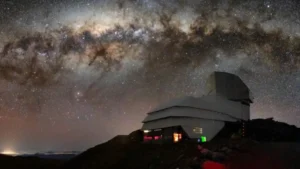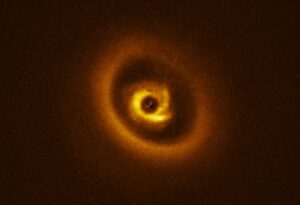Light from a fireball 100 times the size of the solar system, with a brightness of about two trillion times the sun’s, has reached Earth’s telescopes. The explosion — the largest cosmic blast ever registered — has dropped jaws in astronomical circles around the world.
Computers at the Zwicky Transient Facility in California first recorded the event — dubbed AT2021lwx — in 2020. As the BBC reported, the phenomenon wasn’t initially flagged as anything special because no one had taken the time to determine how far away it was.
A cataclysmic event
But when Dr. Philip Wiseman of the University of Southhampton crunched the numbers in 2022, he realized AT2021lwx was eight billion light years away. For something so distant to be so bright meant that this was a truly cataclysmic cosmic event.

This flare of light tipped scientists off to the event. It doesn’t seem like much, but you’d have been reduced to stardust if you were there. Photo: NASA
“We thought, ‘Oh my God, this is outrageous!'” the scientist exclaimed to the BBC.
AT2021lwx is 10 times brighter than a supernova, Wiseman and his team revealed yesterday in the Monthly Notices of the Royal Astronomical Society. And while the light from supernovas tends to fade in a few months, the AT2021lwx explosion has been going strong for over two years.
What could cause such a massive and enduring explosion? Scientists don’t have an immediate answer to that. But as usual, they have a theory.
Supermassive black hole
The current thought is that eight billion years ago, a supermassive black hole gobbled up a tremendous cloud of interstellar gas. It may have been thousands of times larger than our sun. The black hole’s interstellar gluttony released a titanic wash of energy that superheated the remnants of the cloud, which continues to circle the black hole like the universe’s brightest doughnut.
For now, the theory is unproven. But while Wiseman and his team collect more data, other professional star watchers are on the lookout for similar sights.
“It could be that these events, although extremely rare, are so energetic that they are key processes to how the centers of galaxies change over time,” Dr. Robert Massey, Deputy Executive Director of the Royal Astronomical Society, told the BBC.
“We’ve never seen anything like this before…[But] I’d be amazed if this is the only object like this in the Universe.”





